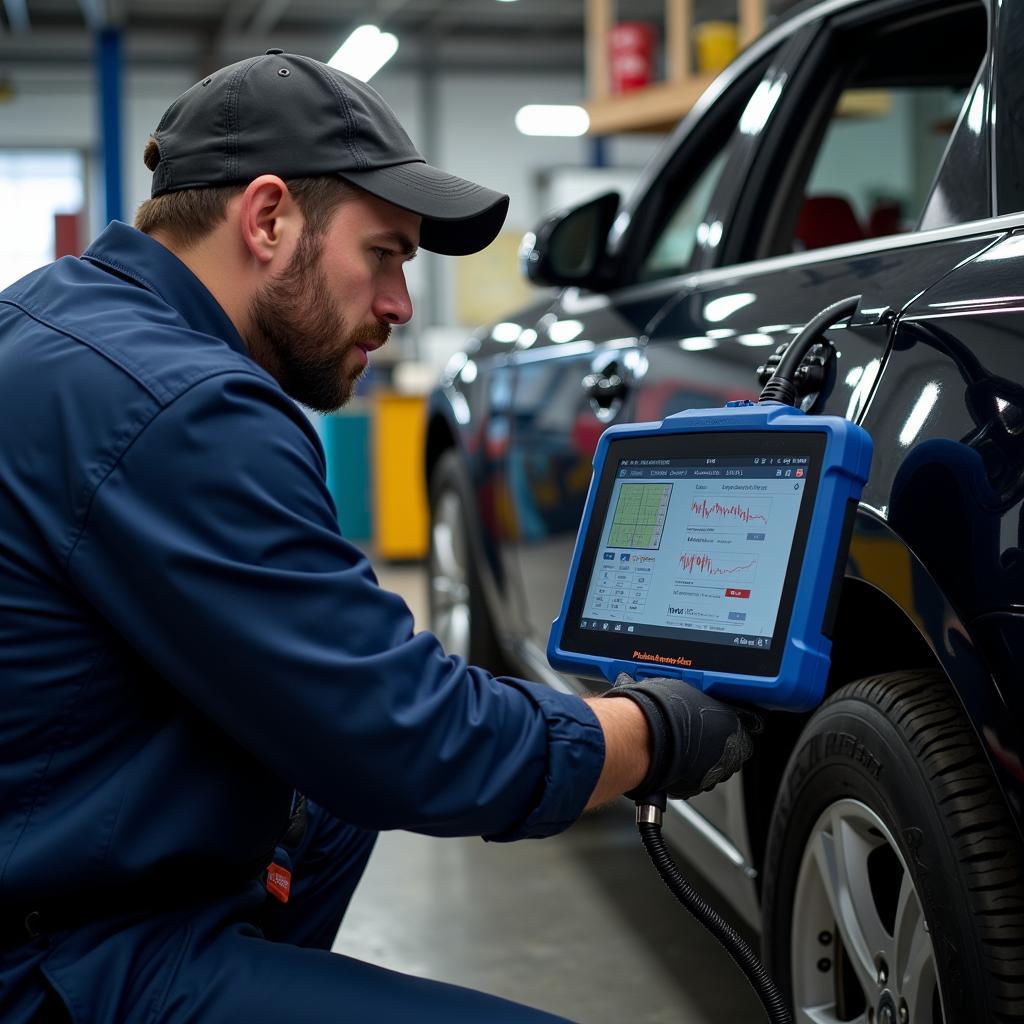A car diagnostic test is a crucial step in identifying problems within a vehicle’s electrical system, engine, and other vital components. Understanding How To Do A Diagnostic Test On A Car can save you time, money, and potential headaches in the long run. This guide provides you with everything you need to know, from the basics to more advanced insights.
What is a Car Diagnostic Test?
Before we delve into the “how-to,” it’s essential to understand what a car diagnostic test actually is. It’s essentially a procedure where a specialized tool, known as an OBD2 scanner, is plugged into your car’s OBD2 port. This scanner communicates with your car’s computer, reading stored diagnostic trouble codes (DTCs) that indicate potential issues.
Why Should You Learn How to Do a Diagnostic Test on a Car?
Knowing how to perform a basic diagnostic test empowers you as a car owner. It allows you to:
- Identify Potential Problems: Detect issues early on before they escalate into major repairs.
- Save Money: Avoid unnecessary trips to the mechanic for a simple diagnostic scan.
- Gain Knowledge: Understand your car’s health better and make informed decisions about repairs.
- Negotiate Fairly: When you have a basic understanding of the problem, you’re in a better position to discuss repairs and costs with a mechanic.
 Car with OBD2 Scanner Connected
Car with OBD2 Scanner Connected
Types of Car Diagnostic Tests
There are two main types of car diagnostic tests:
1. OBD2 Code Reader Test
This is a basic test using a simple code reader that retrieves and displays DTCs. It’s an affordable option for DIY enthusiasts.
2. Professional Diagnostic Scan
Performed by mechanics using advanced scanners, this test provides in-depth data, including live data streams, sensor readings, and more.
 Mechanic Performing Diagnostic Test
Mechanic Performing Diagnostic Test
How to Do a Diagnostic Test on a Car Using an OBD2 Scanner
Here’s a step-by-step guide on how to perform a basic diagnostic test:
- Locate your car’s OBD2 port. It’s typically located under the dashboard on the driver’s side.
- Turn the ignition on but don’t start the engine. This powers up the car’s computer.
- Plug the OBD2 scanner into the port. Ensure it’s securely connected.
- Turn on the scanner and follow the on-screen instructions.
- Select “Read Codes” to retrieve the DTCs stored in your car’s computer.
- Note down the codes. You can then research their meaning online or consult a repair manual.
Understanding Diagnostic Trouble Codes (DTCs)
DTCs are alphanumeric codes that represent specific car problems. They are structured like this:
- First Character: Indicates the system where the issue lies (e.g., “P” for Powertrain, “B” for Body, “C” for Chassis).
- Second Character: Can be a “0” for a standardized code or a “1” for a manufacturer-specific code.
- Third Character: Identifies the specific system or component within the broader category.
- Fourth & Fifth Characters: Represent the actual fault within that component.
For example, a code “P0301” indicates a misfire detected in cylinder 1 within the powertrain system.
Common Car Diagnostic Test FAQs
Here are some frequently asked questions about car diagnostic tests:
1. How Long Does a Car Diagnostic Test Take?
A basic OBD2 code reading takes a few minutes. However, a more comprehensive diagnostic scan by a mechanic might take longer.
2. How Much Does a Diagnostic Test Cost on a Car?
The cost varies. While DIY OBD2 scanners are affordable, professional diagnostic scans at a mechanic’s shop can range from $50 to $150 or more.
3. Can a Diagnostic Test Fix My Car?
No, a diagnostic test only identifies problems; it doesn’t fix them.
4. Will Disconnecting My Car Battery Clear Diagnostic Codes?
Yes, it might temporarily clear the codes, but the underlying problem will likely remain and the codes will reappear.
5. How Often Should I Get a Car Diagnostic Test?
It’s recommended to get a diagnostic test annually as part of your regular car maintenance, or whenever you experience unusual car behavior.
 Car Dashboard with Warning Lights
Car Dashboard with Warning Lights
“Regular car diagnostic tests are an essential part of preventative maintenance,” says John Smith, Senior Automotive Engineer at XYZ Auto. “Early detection can save you from costly repairs down the line.”
Beyond the Basics: Advanced Diagnostic Testing
Professional-grade diagnostic scanners offer functionalities beyond basic code reading, such as:
- Live Data Stream: Monitor real-time sensor readings while driving to pinpoint intermittent issues.
- Actuator Tests: Activate specific components like solenoids or injectors to check their functionality.
- ECU Programming: Update or reprogram your car’s Engine Control Unit (ECU) software.
Conclusion
Knowing how to do a diagnostic test on a car is a valuable skill for any car owner. While basic tests empower you with initial insights, professional scans provide comprehensive diagnostics. Regular car diagnostic testing, coupled with prompt attention to identified issues, ensures your vehicle’s optimal performance and longevity.
For further information on car diagnostics, check out our other helpful resources:
- How long does a car diagnostics test take
- How long does a diagnostic test take on a car
- How much does a diagnostic test cost on a car
If you require expert assistance with car diagnostics or need help understanding specific codes, don’t hesitate to contact us. Our team of experienced technicians is available 24/7 via WhatsApp at +1(641)206-8880 or email us at [email protected].

Leave a Reply